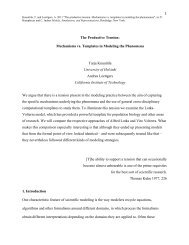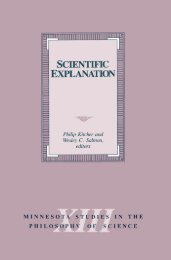The Emergence of First-Order Logic
The Emergence of First-Order Logic
The Emergence of First-Order Logic
Create successful ePaper yourself
Turn your PDF publications into a flip-book with our unique Google optimized e-Paper software.
130 Gregory H. Moore<br />
substitution^ theory. Yet in October 1906, when the Society accepted the paper for publication,<br />
he withdrew it. (It was eventually published as [Russell 1973].) <strong>The</strong> version <strong>of</strong> the theory<br />
<strong>of</strong> types given in the Principles was very close to his later no-classes theory. Indeed, he wrote<br />
that "technically, the theory <strong>of</strong> types suggested in Appendix B [1903] differs little from the<br />
no-classes theory. <strong>The</strong> only thing that induced me at that time to retain classes was the technical<br />
difficulty <strong>of</strong> stating the propositions <strong>of</strong> elementary arithmetic without them" (1973, 193).<br />
12. Hilbert's courses were as follows: "Logische Prinzipien des mathematischen Denkens"<br />
(summer semester, 1905), "Prinzipien der Mathematik" (summer semester, 1908), "Elemente<br />
und Prinzipienfragen der Mathematik" (summer semester, 1910), "Einige Abschnitte aus<br />
der Vorlesung tiber die Grundlagen der Mathematik und Physik" (summer semester, 1913),<br />
and "Prinzipien der Mathematik und Logik" (winter semester, 1917). A copy <strong>of</strong> the 1913<br />
lectures can be found in Hilbert's Nachlass in the Handschriftenabteilung <strong>of</strong> the Niedersachsische<br />
Staats- und Universitatsbibliotek in GOttingen: the others are kept in the "Giftschrank"<br />
at the Mathematische Institut in GOttingen. Likewise, all other lecture courses given<br />
by Hilbert and mentioned in this paper can be found in the "Giftschrank."<br />
13. See (Hilbert 1917, 190) and (Hilbert and Ackermann 1928, 83). <strong>The</strong> editors <strong>of</strong> Hilbert's<br />
collected works were careful to distinguish the Principle <strong>of</strong> Mathematical Induction in (Hilbert<br />
1922) from the first-order axiom schema <strong>of</strong> mathematical induction; see (Hilbert 1935,176n).<br />
Herbrand also realized that in first-order logic this principle becomes an axiom schema (1929;<br />
1930, chap. 4.8).<br />
14. <strong>The</strong> course was entitled "Logische Grundlagen der Mathematik."<br />
15. "Logische Grundlagen der Mathematik," a partial copy <strong>of</strong> which is kept in the university<br />
archives at GOttingen. On the history <strong>of</strong> the Axiom <strong>of</strong> Choice, see (Moore 1982).<br />
16. Bernays also wrote about second-order logic briefly in his (1928).<br />
17.On the early history oif the w-rule see (Feferman 1986)<br />
18. See, for example, (van Heijenoort 1967, 230; Vaught 1974, 156; Wang 1970, 27).<br />
19. <strong>The</strong> recognition that Skolem in (1920) was primarily working in Lw is due to<br />
Vaught (1974, 166). ''<br />
20. For an analysis <strong>of</strong> Zermelo's views on logic, see (Moore 1980, 120-36).<br />
21. During the same period Skolem (1961, 218) supported the interpretation <strong>of</strong> the theory<br />
<strong>of</strong> types as a many-sorted theory within first-order logic. Such an interpretation was given<br />
by Gilmore (1957), who showed that a many-sorted theory <strong>of</strong> types in first-order logic has<br />
the same valid sentences as the simple theory <strong>of</strong> types (whose semantics was to be based<br />
on Henkin's notion <strong>of</strong> general model rather than on the usual notion <strong>of</strong> higher-order model).<br />
22. See (Quine 1970, 64-70). For a rebuttal <strong>of</strong> some <strong>of</strong> Quine's claims, see (Boolos 1975).<br />
23. For the impressive body <strong>of</strong> recent research on stronger logics, see (Barwise and Feferman<br />
1985).<br />
References<br />
Ackermann, W. 1925. Begrtlndung des "Tertium non datur' mittels der Hilbertschen <strong>The</strong>orie<br />
der Widerspruchsfreiheit. Mathematische Annalen 93: 1-36.<br />
Barwise, J., and Feferman, S. eds. 1985. Model-<strong>The</strong>oretic <strong>Logic</strong>s. New York: Springer.<br />
Bell, D. 1984. Russell's Correspondence with Frege. Russell: <strong>The</strong> Journal <strong>of</strong> the Bertrand<br />
Russell Archives (n.s.) 2: 159-70.<br />
Bernays, P. 1918. Beitrage zur axiomatischen Behandlung des Logik-Kalkuls. Habilitationsschrift,<br />
GOttingen.<br />
1928. Die Philosophic der Mathematik und die Hilbertsche Beweistheorie. Blatter fur<br />
Deutsche Philosophic 4: 326-67. Reprinted in (Bernays 1976), pp. 17-61.<br />
-1976. Abhandlungen zur Philosophic der Mathematik. Darmstadt: Wissenschaftliche<br />
Buchgesellschaft.<br />
Bernays, P., and SchOnfinkel, M. 1928. Zum Entscheidungsproblem der mathematischen<br />
Logik. Mathematische Annalen 99: 342-72.<br />
Boole, G. 1847. <strong>The</strong> Mathematical Analysis <strong>of</strong> <strong>Logic</strong>. Being an Essay toward a Calculus<br />
<strong>of</strong> Deductive Reasoning. London.




